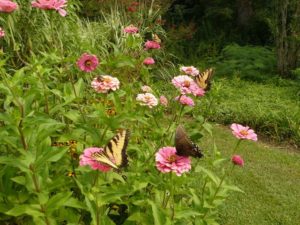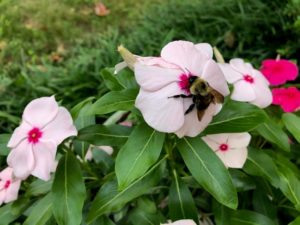
Gardens can be transformed into mini-sanctuaries for wildlife and areas that attract birds, bees, butterflies, and other pollinators. The process involves improving elements in the landscape and concentrating gardening efforts on creating beneficial habitats.
“My garden habitats are designed to sustain birds, bees, and butterflies,” said Janice Mahoney, a Northern Neck Master Gardener. “I ensure that I provide four essential ingredients: water, food, cover, and space.”
All wildlife species need water for drinking. Birds also need water for bathing. If birds cannot bathe, their feathers become dirty making flight difficult. The best water source for birds and butterflies is a birdbath no more than 3 inches deep. By adding pebbles or larger rocks to the basin, the birdbath becomes a water source for butterflies.
Mahoney states that food sources vary for birds, bees, and butterflies. “Birds eat nuts, berries, seeds, and insects. The insects provide essential proteins for adult birds and their fledglings. Some common seed sources are sunflower seeds and the seeds in the cones of pines and firs. Favorite berries are available from the American holly, dogwoods, and blueberry and blackberry bushes.”
Research indicates that more than 40% of insect species are declining and a third are endangered. Bees, butterflies, moths, beetles, dragonflies, and damselflies are some of the most affected species. Insects provide protein especially to bird fledglings. Without insects, bird populations would decline. Insects pollinate approximately 80% of flowering plants including commercial agriculture.
Nectar from flowering plants is the main food source for bees. Common nectar plants in the Northern Neck are sunflowers, coneflowers, bee balm, zinnias, asters, and lantana.
“There are four thousand species of bees in North America, and bees are our most important and efficient pollinators,” continued Mahoney. “Bumble bees form hives but most native bees are solitary and lay their eggs in ground tunnels, hollow plant stems, or decaying wood.”
Honeybees are not native to the United States. They were imported from Europe for agricultural pollination and honey production.
Butterflies require two different food sources, host plants and nectar plants. Butterflies lay their eggs on a host plant, which then provides the food for the caterpillar as it goes through its metamorphosis into an adult butterfly. Each butterfly species has specific host plants for its eggs and caterpillars. Host plants for caterpillars include white clover, dill, fennel, parsley, and milkweed.

“Monarch caterpillars feed exclusively on milkweed. You must plant milkweed if you want to attract monarchs to your yard,” Mahoney said. “Adding butterfly weed to your landscape will also add a bright note of orange to your plantings.”
Once the caterpillar transforms into an adult butterfly, the food resources are the same flowering nectar plants that feed the bees.
“Wildlife needs the space to find safe places to reproduce and to protect and nourish their young,” Mahoney continued. “Cover provides wildlife with shelter from extreme heat and cold, high winds, storms, and predators. Trees, shrubs, grasses, and flowering plants provide cover, as do rock piles, brush piles, cavities in trees, and birdhouses.”
Mahoney concluded, “Remember, habitat gardeners manage the habitat, not the wildlife within it.”
